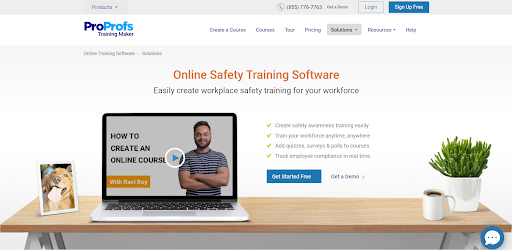Along with logging, refuse collection, and truck driving, construction is considered a high-risk occupation. That’s why construction safety training is so important.
As of 2022, there are 10,019,790 employees in the construction industry.
In 2020, more than 130,000 construction workers lost their work time due to illness or injuries.
Roughly 20% of worker fatalities are reported from this industry, costing companies billions of dollars each year.
Despite this, many construction workers believe that the safety training they receive is insufficient.
To build a culture of safety in the workplace, you need to train your employees on different topics, including those required by laws.
Continue reading to find out what construction safety training is, why it is important, and how to develop a safety training program.
What is Safety Training for Construction Workers?
Construction safety training is a mandatory training program for construction workers to ensure safety and well-being while performing their duties. Examples of safety training include fall protection, HAZMAT, and personal protective equipment (PPE). These programs are generally implemented under the direction of OSHA and the U.S. Department of Transportation (DOT).
During the training, construction workers are trained in the following safety areas:
- Proper use of safety gears
- Precautions while working at heights & scaffoldings
- Electrical safety
- Fire safety
- First aid administration
- Lockout/Tagout (LOTO)
Such training aims to enable employees to take safety due diligence and keep themselves and others safe.
Why is Construction Safety Training Important?
Don’t learn safety rules by accident.
Safety training is vital for blue-collar workers who perform manual labor and use heavy machinery, equipment, and props. These are some of the real benefits of safety training programs:
- Employee Safety
Construction workers often expose themselves to the risks of injuries and even deaths because of the nature of their job. But through systematic training, they learn the do’s and don’ts or the precautionary measures they need to take to play it safe.
Training educates them on embracing safety practices and creating a safe environment where they can work without risks to their health. For example, the correct use of work tools and safety gear is a major part of such training intended to keep dangers at bay.
Watch: Forklift Safety Training Course
- Unhampered Productivity

Safety training in the construction industry is significant for ensuring uninterrupted employee productivity. In fact, workers’ safety and productivity go hand in hand. When there is no threat of physical or psychological injuries, workers can perform their duties at the optimal level.
A construction worker training program can increase the capacity of employees and the quality of their work by sensitizing them on safety protocols. Training shows them how to engage with their daily work in the safest way possible without letting injuries impact their duties.
Watch: Drug-Free Workplace Training Course
- Reduced Absenteeism
The cost of employee absenteeism is $1,685 per employee per year.
When employees are incapacitated due to an injury or illness, they cannot go to work as regularly as they used to, and so their attendance suffers.
A well-trained construction employee knows how to protect themselves from possible injuries and illnesses. This, in turn, keeps employee absenteeism to a minimum. Since they are not deprived of their strength in any way, there is no reason to stay away from work.
- Cost-Saving
By helping build a workplace safety culture, construction safety training eliminates the costs of injury claims and compensations.
Companies can avoid two types of costs. While medical expenditures and litigation costs come under direct costs, costs related to disrupted work schedules, loss of productivity, and employee replacement are indirect costs.
When companies provide a safety net to their employees to protect them from all possible workplace hazards, they need not spend these preventable costs. In other words, improved safety practices through formal training can save you money.
- Better Collaboration

Effective communication and collaboration are at the heart of construction. But when we are talking about large-scale projects involving numerous stakeholders with different goals and interests, staying on the same page can be challenging.
A detailed employee training program can be a solution here. It can teach the entire team about information sharing & collaboration, and provide direction to achieve specific goals.
This aspect of a project is inextricably related to workforce productivity. The faster and easier people communicate, the better the results.
- Fewer Project Disputes
A few years back, the construction industry lost $42.8 million due to project disputes. The reasons behind such a terrifying number may vary, but at the end of the day, everything boils down to a lack of preparedness.
Of course, as a construction project develops, there may be unpredictable incidents. What can be predicted is the creation of a detailed contract and employee training, which covers all contingencies in different risk scenarios.
Training to avoid project conflicts might sound like a long shot but it actually isn’t. You can build a learning culture for your team through an elaborate training program and make projects less prone to errors and disputes.
- Less Rework Time
Last but certainly not least, proper training can play a decisive role in lowering rework time in construction. As reported by McKinsey and Company, high rework rates are at the moment one of the elements that haunt the whole building sector and hinder its further development.
More specifically, the rework rates in construction are high. 30% of all the work performed by construction companies constitutes rework. It’s safe to say, then, that something needs to be done to change this trend in the construction industry.
Training is one of the factors that can drastically change the way your construction workers work for the better and set certain standards. All team members must receive proper training that prepares them fully for project success.
What Skills Construction Workers Can Develop Through Safety Training?
Safety training for construction workers can help employees pick up all the essential skills directly or indirectly related to safety. Find out some of the construction worker skills in this regard.
-
Material & Equipment Handling
You may call it the most basic of all skills expected of a construction worker. Safe handling of construction materials and equipment is one of the essential topics in every construction training program.
Through demonstration and practical tips, workers can learn how to unload and move goods safely in and around a construction site. Similarly, they can learn how to start and stop a machine or equipment and place them safely after use.
-
Hand-Eye Coordination
The need for alertness and quick thinking is high among construction workers. Hand-eye coordination and dexterity are a part of the skills that help workers direct their attention to tasks and control and execute them.
Safety training can help them develop the coordination and agility necessary to handle different machines, see things clearly from a distance, catch or hold construction items. All this enables them to stay clear of any dangers or accidents.
Watch: How to Protect Workers From Fall Hazards | Training Course Introduction
-
Physical Endurance
Construction is a physically demanding job and so the need to maintain fitness is paramount for employees. They would often sit, stand, or lie down at work for hours, which requires muscular strength. In short, it is a test of endurance.
As a part of their safety manual and skills training, you can recommend bouts of exercises as a part of their daily routines. This will strengthen them for heavy lifting, help maintain good postures, and build stamina over time.
Watch: Preventing Musculoskeletal Disorders
-
Technology Skills
An equally significant contribution of safety training is technology training. In recent years, the construction and engineering industry has adopted modern technologies to assist employees in their day-to-day jobs, achieve increased levels of efficiency and safety, and remain competitive.
For example, you can train construction workers to use drones to inspect hard-to-reach areas such as tall buildings and under bridges. Similarly, training on field data collection apps can make workers knowledgeable about collecting data from construction sites for inspections, maintenance, and audits.
A just-in-time training program can also be very beneficial here. Read more about it in our blog on Just-in-Time Training: Benefits & Best Practices.
-
Leadership Abilities
Leadership plays a remarkable role in ensuring the safety and well-being of construction workers. At some point in time, someone has to take the lead, set safety standards, and ensure that employers follow them.
During role-based safety training, you can educate workers on the importance of safety leadership and how they can play a constructive role to keep themselves and their co-workers safe.
-
Communication Skills
Timely communication can help improve team collaboration and accelerate successful project completion. But more importantly, it can help avert mishaps that damage properties and lead to human injuries and fatalities.
A part of construction safety training should be dedicated to enhancing the communication skills of workers. When they communicate issues in their work to their supervisors, it draws the latter’s attention to those areas and enables the management to take action before any real harm is done.

What Topics Should I Cover in Construction Safety Training?
When it comes to topics for safety training, the sky’s the limit. You can include any safety-related topics that you deem fit for your employees to know for their impact.
That said, if you’re still unsure about what to cover in a safety training program, here is a checklist.
- Hazard Identification
- Slips, Trips, & Falls
- First Aid
- Eye Protection
- Ladder/Scaffolding Safety
- Safe Lifting
- Signs, Signals, & Barricades
- PPE
- Lockout/Tagout Procedures
- Fire Safety
- Electrical Safety
- Accident Documentation & Reporting
Watch: Ladder Safety Training
Watch: Injury Prevention in the Workplace
Get Free Employee Training Software — All Features, Forever.
We've helped 567 companies train 200,000+ employees. Create courses in under a minute with our AI LMS or use 200+ ready-made courses on compliance, harassment, DEI, onboarding, and more!
How to Create a Construction Safety Training Plan
You know the magnitude of safety issues in the construction industry. You also know how important it is to run safety training for your employees. But unless you have a solid plan in place, you won’t be able to make much headway or see the results of your efforts.
To build a safety training plan for your company, keep the following action items in mind:
-
Conduct a Job Safety Analysis
You just can’t get up one day and shout, “We’re giving you safety training today.” You first need to understand the nature of safety issues that a job role presents to your workers. This is where you need to perform a job safety analysis.
You need to find out the history of safety-related incidents in your company, their frequency, how they affected your workers, what steps you took to prevent them from recurring, and whether they were effective.
Once you’ve got that in front of you, you will know the level of safety in your organization. This will decide your future training and course of action.
-
Involve Top Management

When there is management buy-in during a critical program like safety training, it can give a ripple effect. The interest and support shown from the top is proof of commitment to workers’ safety. It makes employees willing participants in the training program as they are more likely to cooperate with you for a larger cause.
Make sure you make time for frequent interactions between construction workers and their supervisors before, during, and after the training. This will keep the employees motivated, help you align them with your training plan, and ensure compliance.
-
Stay Up-to-date With Compliance Rules
Safety rules and regulations such as OSHA are revised now and then to help organizations implement more effective safety standards for their employees. As employers and employees who need to abide by these rulebooks in letter and spirit, you and your staff can only stay up-to-date with them.
This will ensure that you stay compliant with the latest laws, keep your employees safe and sound, and remove legal liabilities. Your safety training plan should reflect these changes so that you can deliver relevant and accurate safety information.
Watch: What is OSHA Compliance Training? Requirements & Benefits
-
Emphasize Accountability
If you think workplace safety is the sole responsibility of safety managers, think again. It is the obligation of every worker on-site to ensure their safety and the safety of others.
All of them should identify hazards and report them to the right authority so that you can take action on time. Hold everyone accountable for maintaining certain safety standards. You should include this message in your training plan.
-
Use the Best Training Software

You may have stellar safety training ideas, but they will miscarry unless you utilize the right tool to implement them. One of the finest tools you can use for safety awareness training is a learning management system or LMS in short.
Using these all-in-one platforms, you can easily create construction safety training courses and assessments, train your workers anytime, anywhere, and on any device, track compliance in real-time, and view insightful reports and analytics.
This way, you can streamline your construction safety training online for simplicity, efficiency, and speed.
-
Choose the Best Courses
After you adopt employee training software, you are one step closer to a full-fledged safety program. What you need is an online safety training course. Many of these courses are professionally designed and customizable. You can add your safety policies and personalize the training with branding.
They are tailored for maximum engagement, and since they are online, participants can self-pace how, when, and where they learn. Make sure the course you choose supports quizzes, videos, surveys, and gamification for an interactive eLearning experience.
-
Conduct Regular Inspections
These inspections are a way to ensure that your workers are doing their jobs safely. Inspections can reinforce safety training programs.
A site inspection should note whether tools and machines are stored properly, whether they are functioning as they should, or whether your employees are operating them according to safety guidelines. It should also see that first aid and other medical assistance are in place for emergencies.
Use a safety inspection checklist to ensure strict enforcement of safety measures.
-
Build a Culture of Safety

A one-time safety training program for construction workers won’t cut it. You need to create a sustainable culture of “safety-first” behaviors in the workplace for ongoing compliance.
For this, there should be transparency and accountability on every employee’s part. Encourage open communication. Create and enforce safety rules strictly. Employees at all levels should come under the purview of these directives.
Never Compromise on Your Workers’ Safety
Employee safety is both a legal and moral responsibility of every employer. For a high-risk occupation like construction, safety training is particularly important as the nature of the job has a significant impact on workers’ health.
Construction workers should cultivate a habit of keeping themselves and others safe and remove all kinds of human and business liabilities. That calls for a systematic and formal safety training plan based on industry best practices.
A thorough job safety analysis should precede such a program. It should gain the support of top management and adhere to the latest compliance requirements. Also, you should deploy the best training software and courses to achieve the best results.
 Tips
Tips
We’d love to hear your tips & suggestions on this article!
Get Free Employee Training Software — All Features, Forever.
We've helped 567 companies train 200,000+ employees. Create courses in under a minute with our AI LMS or use 200+ ready-made courses on compliance, harassment, DEI, onboarding, and more!

 We'd love your feedback!
We'd love your feedback! Thanks for your feedback!
Thanks for your feedback!







